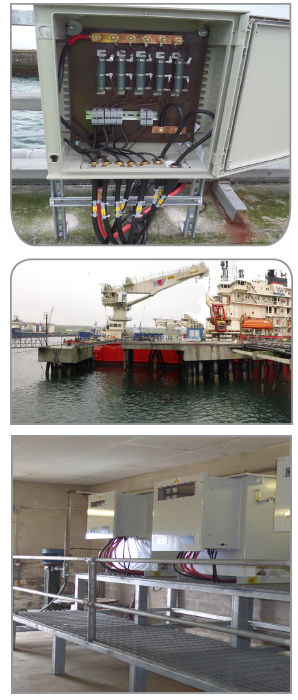 Impressed Current Cathodic Protection
Impressed Current Cathodic Protection
Client
Peterhead Port Authority
Subcontract Divers
Caldive
Electrical Services
J.Buchan
Value
£250,000
Works Commenced – Completed
July 2014 – August 2015
The existing cathodic protection (CP) system on the Tanker Jetty was damaged following a severe storm damage, which removed power distribution and anode cables and caused the control rectifier to overheat, rendering the CP beyond repair.
A new replacement installation was needed to address the issues of underprotection coverage to parts of the jetty and also to update the anode design impressed current system covering the support piles to the jetty approach road, jetty head, loading areas and mooring/berthing dolphins.
Trials were carried out at site using a temporary generator and portable mixed metal anodes to establish the criteria for zone current distribution for the key parts of the jetty. Testing also included checking of the continuity throughout the structure to ensure balance distribution and control of current over the system.
Following site appraisal and investigation, the system design was based on utilising power distribution from four rectifiers, two 300A and one 150A dual output oil cooled transformer rectifiers, controlling four separate zone configurations on the jetty site. The transformer units were installed in the existing jetty head control building and were set on a raised galvanised platform one metre above the floor to negate the risk of exposure to flood water ingress during high storm conditions.
Within the four zones the current was dispersed through 37 CCSL designed mix metal anodes set within shielded dielectric tubes and each separately mounted on a top/bottom bracelet bracket arrangement to individual designated steel piles. The steel bracelets were made in Freyssinet’s factory by shot blasting to SA 2.5 and brush applied painted and coated to a high specification using Umeguard SX epoxy paint. The negative and test cable structure connections for each zone were housed in prefabricated boxes similarly treated with Umeguard and encapsulated in Marine grade resin before being welded to the top of the pile at each designated location.
Anodes and frames were preassemble prior to delivery to site and quality control checked at each stage. The design of the anode / bracelet reduced the site fitting and dive team time at site, enabling ease of fitting, setting the anodes at LAT – sub sea by the diving subcontractor from a self contained operational work boat and platform.
Individual anode cable management was achieved using HCL smart banded 32mm straps fitted around the pile with buckle clips with clamping tools. Cables were routed to the 11 control junction boxes and fitted to bus bars through variable control resistors. The junction boxes were mounted on frame supports adjacent to the road barrier and hand rails.
Positive and negative feed cables from the transformer rectifier control building were fitted on new and existing cable trays for distribution around the jetty and dolphin locations, terminating at each junction box.
Following the fitting of the new AC 3 phase power supply to the transformer, rectifiers and pretesting checks the CP system was energised and outputs adjusted after an initial period of polarisation.
A full dipping survey utilising portable silver/silver chloride seawater reference cells was carried out to verify the structure CP had achieved outputs in accordance with the design specification criteria.
The zonal layout design enables ease of access and control maintenance of the CP system and included localised test connections for future monitoring of the CP system.
The project was completed and successfully commissioned within the time schedule and allowed for minimal disruption to the planned jetty operational berthing activities throughout.
